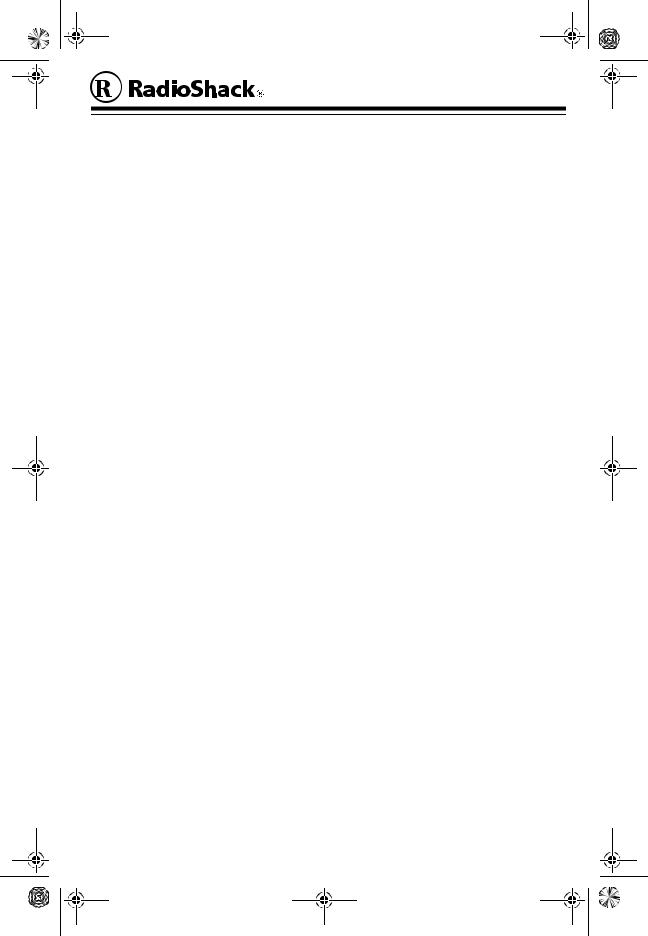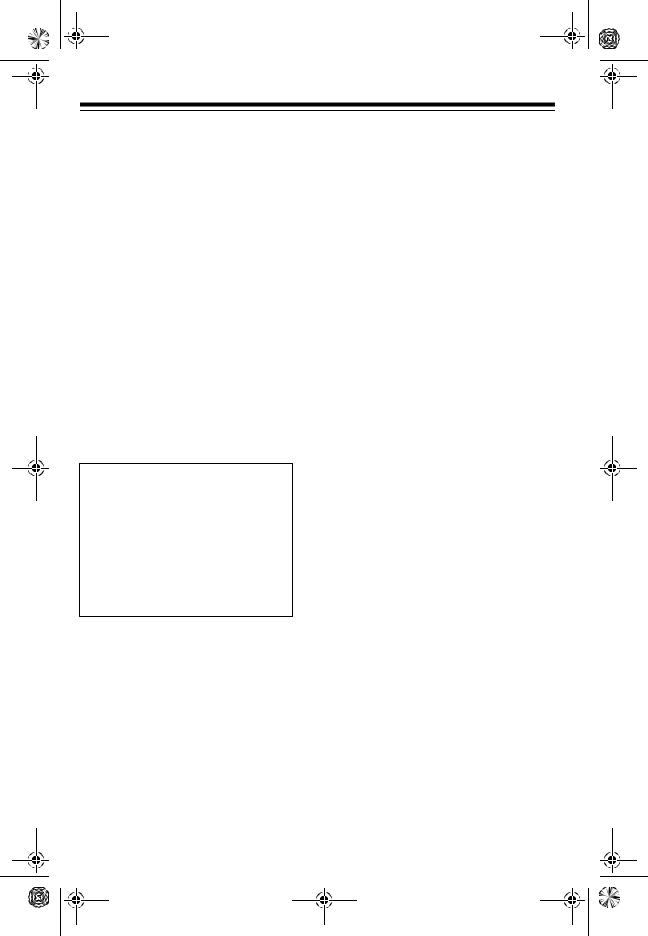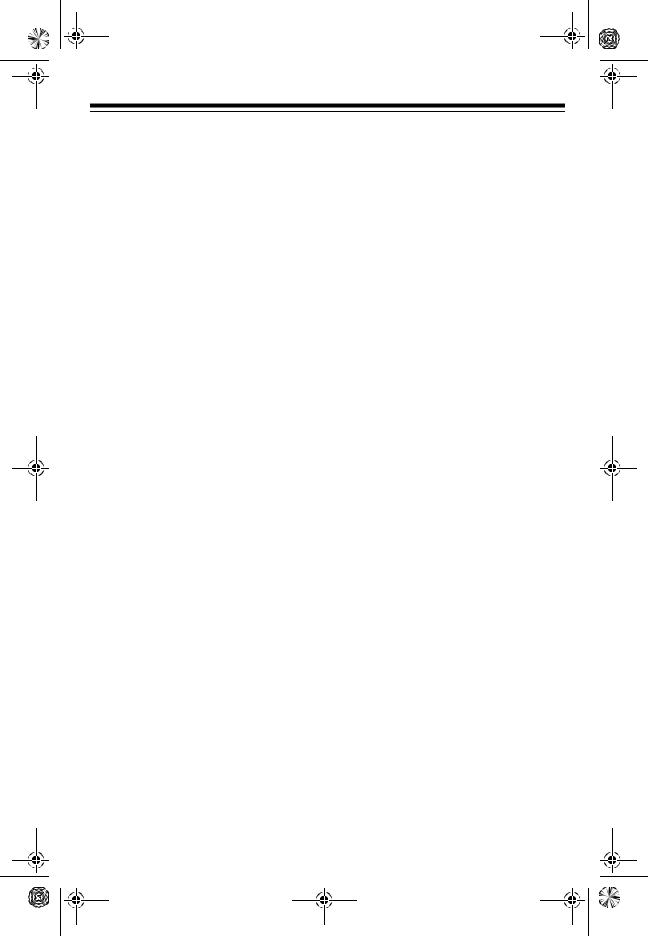Radio Shack 10M User Manual

21-869.fm Page 1 Wednesday, October 13, 1999 11:50 AM
Cat. No. 21-869
10M Ham/CB Base Antenna
Your RadioShack 10M Ham/CB Base Antenna provides excellent reception of amateur radio, CB, and commercial radio signals. The antenna can handle up to 2000 watts of transmit power.
Your antenna’s features include:
Electrical Half-Wave Design — provides high gain.
Note: To improve your antenna’s gain, you can connect an optional ground plane kit (available through your local RadioShack store) to your antenna.
Three Easy-to-Assemble Sections — help you quickly and easily assemble the antenna.
Dual Tuning Rings — help you quickly set the antenna for optimum performance over a wide range of frequencies.
Ultraviolet Inhibitor — the antenna’s UV-protected housing is made of impactresistant fiberglass, making the exterior resistant to weathering and color change.
Strong Internal Construction — prevents the antenna’s internal wires from rattling, for maximum strength.
IMPORTANT SAFETY PRECAUTIONS
Many do-it-yourself and professional antenna installers are injured or killed each year by electric shock. Many power wires are within 20 to 25 feet of the ground and could easily be touched by an assembled antenna or cable. Touching the overhead wires with any part of the antenna is the same as touching the wires with your bare hand. Contacting an electrical wire almost always results in a very serious shock.
To avoid electric shock, please read and follow these important safety precautions:
•Be sure to select an antenna site well away from all overhead wires.
•Do not try to guess which overhead wires carry high voltage. Check with the power company.
•If you notice anything making contact with the overhead wires, call the power company to have it removed.
•Do not run the antenna’s cable over power wires.
•Get help from a qualified professional when removing the old antenna, especially if you have any doubt about clearing overhead wires.
•Never install an antenna by yourself. Be sure to have at least two people available for help.
•Never install an antenna on a windy day.
©1999 Tandy Corporation. All Rights Reserved.
RadioShack is a registered trademark used by Tandy Corporation.

21-869.fm Page 2 Wednesday, October 13, 1999 11:50 AM
BEFORE YOU BEGIN
When deciding on an antenna’s location, consider these points:
•The antenna should be as high as possible on the building.
•The antenna and its cable should be as far as possible from sources of electrical noise such as appliances or other radios.
•The antenna should be vertical for the best performance.
Always use 50-ohm coaxial cable, such as RG-58 or RG-8, to connect the antenna to your radio. For lengths over 50 feet, use RG-8 low-loss dielectric coaxial cable. Your local RadioShack store carries a wide variety of coaxial antenna cable and connectors.
Warning: When you install an outdoor antenna, use extreme caution. If the antenna starts to fall, let it go! It could contact overhead power lines. If the antenna touches the power line, contact with the antenna, mast, cable, or guy wires can cause electrocution and death. Call the power company to remove the antenna. Do not attempt to remove it yourself!
Cautions:
•Do not run the cable over sharp edges or moving parts that might damage it.
•Do not run the cable next to power cables or other antenna cables.
2
Coaxial Cable Installation
Precautions
•Do not install coaxial cable where it will have a pulling tension of greater than 50 pounds. Leave no tension on the cable after installing it.
•Use only round-headed staples. Any clamps or securing devices used with coaxial cable should grip the cable evenly about the circumference without crushing the cable. Flat staples can damage coaxial cable.
•Do not expose coaxial cable to a temperature greater than 176°F (80°C). Keep the cable away from heating vents and water heaters.
•Do not install coaxial cable where it will be crushed, stuffed, wedged, or pinched.
•The cable’s jacket withstands most outdoor environments. However, you must seal connections and splices to prevent moisture from entering them.

21-869.fm Page 3 Wednesday, October 13, 1999 11:50 AM
PREPARATION
Pre-Tuning the Antenna
Your antenna is preset to use 27.205 MHz (the middle of the CB band) for the lowest SWR. If you are using your antenna with a CB radio, you do not have to pre-tune it. See “Assembling and Mounting the Antenna” on Page 3.
Before you assemble and mount the antenna, you must determine the frequency range you will be using with it. If you are not using CB frequencies, you must either trim the antenna’s top element to match the range you are using or use an antenna tuner (not supplied) to electrically trim the antenna.
Caution: To avoid damaging the antenna, do not trim the antenna’s middle or bottom elements.
If you are using your antenna with an amateur radio and want to trim the antenna’s top element to pre-tune it, follow these steps.
1.Use the following chart to determine how much you need to trim off of the top element (if any).
For example, to pre-tune the antenna to use a frequency of 29.328 MHz, you must cut off enough of the top element (about 21 inches) to leave it approximately 51 inches in length.
2.Remove the cap from the top of the top element.
3.Use a tape measure to measure the length you need to cut off of the top element, then use a hacksaw to carefully cut the top element.
4.Replace the cap on the top element.
5.Set the tuning rings on the bottom element of the antenna to their lowest position.
Note: If you trim too much off of the top element or use the antenna for a different frequency later, you can order a replacement top element from your local RadioShack store.
If you need to pre-tune the antenna to a frequency lower than 28 MHz, use an antenna tuner (not supplied).
Assembling and Mounting
the Antenna
Before you can use the antenna, you must assemble and mount it then connect it to your radio. You can mount the antenna outdoors on a vertical, solid object such as a TV antenna mast. For the best results, mount the antenna vertically as high as possible away from trees or other obstructions. (Higher frequencies are noticeably affected by obstructions.)
Important:
•Do not mount the antenna on a metal surface such as aluminum siding. This greatly reduces the antenna’s ability to receive signals.
•Before you assemble the antenna, prepare the structure that you will mount it to. RadioShack stores carry standard TV masts which you can use to mount the antenna. Make sure the supplied U-bolts will fit around whichever mast you choose.
3
